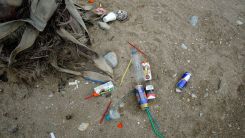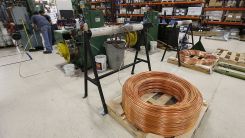
Mark Bustos

3D Printed Nose Cartilage: Is It a Safer, Easier Alternative for Skin Cancer Patients?

Nanoparticle Drug Delivery Could Boost Bowel Cancer Odds

AR/VR Glasses of the Future Need Not Be Bulky, Bug-Eyed with New Technology
10,000-Year-Old Mammoth Bone in Florida River Found by Divers in Florida
Four Types of Alzheimer's Disease and How Machine Learning Helped Identify Them

South Africa to Ban the Breeding of Lions for Sport, Petting

NASA's Hubble Releases New Image of the Stunning "Necklace Nebula"

12,000 Genetically Modified Mosquito Eggs Scattered in Florida as “Living Insecticides”
Big Catch! Giant 100-Year-Old, 7-Feet Long Sturgeon Caught in Detroit

Ice Age Discovery: Las Vegas Workers Find Ancient Horse Remains While Digging Swimming Pool

Donkeys Unexpectedly Help Save Lives in the Desert, New Study Reveals
Exoplanet Discovery: NASA's Hubble Space Telescope Witnesses Growing, Feeding Giant Planet

Havana Syndrome? US Federal Gov't on the Tail of Mysterious "Energy Attack" Near White House

Track Marine Litter Anywhere in the World With This New Interactive Website
Quantum Tech One Step Closer With New Single Photon Switch

Przewalski's Horses: Last Wild Species Found Thriving in Chernobyl

Secrets of Kraken Giant Squid That Allegedly Drags Sailors and Ships Revealed, Are They Really Dangerous?

NEC Corporation Supports Kenya's Fight Against COVID-19

ESWET Calls for Additional Support from EU Taxonomy for a Carbon-Neutral Europe

Corn Waste Finds New Purpose in Water Treatment Studies
Seafloor Mapping Reveals 25,000 Barrels of Waste, Toxic Debris Off Los Angeles Coast

Bacteria Could Help Synthesize Safe, Stable Copper, Study Shows
China's Chang'e 6 Lunar Probe on 2024 to Showcase Equipment from European Countries

Zoom Dysmorphia: Dermatologists Report Rise in Cosmetic Consultations; Here's What to Do
Sky Ladder, Manned Lunar Rover May Be Chinese Scientists Next Plan for Moon Transport
MIT Study Counts Pedestrians to Guide Urban Planning

Mankind Has Sustainably Shaped Earth for at Least 12,000 Years
Meteor Shower 2021 Schedule: When is the Next Sky Show After Lyrid's Peak?

Tarantulas Almost Everywhere Because of the Continental Drift
Most Popular

Microplastics Are Everywhere — How Plastic Pollution Threatens Wildlife, Soil, and Water

Brain Health Aging Guide: Effective Strategies for Cognitive Decline Prevention and Lower Dementia Risk

Mitochondrial Health and Aging: How Cell Energy Drives Modern Anti-Aging Science

How Scientists Use Radio Telescopes to Search for Alien Signals Across the Universe




